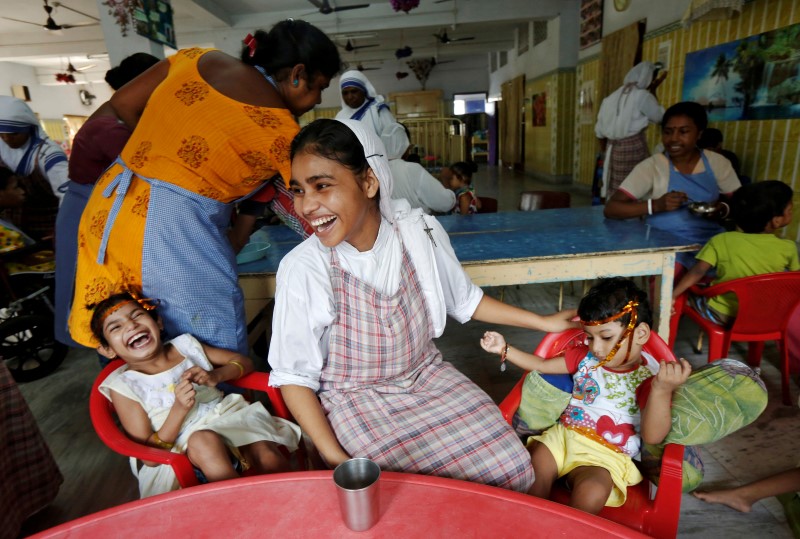
By Subrata Nagchoudhury and Sunil Kataria
KOLKATA, India (Reuters) – On the eve of her canonization as a Roman Catholic saint, and 19 years after her death, the order founded by Mother Teresa of Calcutta is going strong – even without her charismatic leadership.
The Missionaries of Charity gained world renown, and Mother Teresa a Nobel peace prize, by caring for the dying, the homeless and orphans gathered from the teeming streets of the city in eastern India.
They also drew criticism for propagating what one skeptic has called a cult of suffering; for failing to treat people whose lives might have been saved with hospital care; and for trying to convert the destitute to Christianity.
While staying true to their cause, the Missionaries of Charity say they have responded to their detractors.
“There is no change in our way of treating the sick and dying – we follow the same rule that Mother had introduced,” said Sister Nicole, who runs the Nirmal Hriday home in the ancient district of Kalighat, the first to be set up by Mother Teresa in 1952.
The nuns no longer picked up people “randomly” off the streets, she said, and only took in the destitute at the request of police.
“Any good work will be challenged – but if the work is genuinely good it will survive such criticism and carry on to be God’s true work,” said Nicole.
PRAYER AND WORK
Hundreds of thousands are expected to gather in Rome on Sunday for a canonization service led by Pope Francis, leader of the world’s 1.2 billion Roman Catholics, in front of St Peter’s Basilica.
Kolkata, as the former capital of the British Raj is now called, is holding prayers, talks and cultural events. But no major ceremony is planned to mark the path to sainthood for the two miracles of healing attributed to Mother Teresa.
The low-key mood reflects an often-heated debate over religious intolerance in India, a predominantly Hindu country of 1.3 billion people.
Although Prime Minister Narendra Modi has said Indians felt “proud” about the canonization, the head of a Hindu grassroots movement that supports his government provoked controversy last year by accusing Mother Teresa of seeking to convert people to Christianity. Her order denies this.
Kolkata Archbishop Thomas D’Souza played down any suggestion that Mother Teresa was not loved and respected by people of other faiths in a city that is home to 170,000 Roman Catholics.
“Mother is certainly not a goddess to them,” he told Reuters. “But she is deeply venerated and people – cutting across caste, community and creed – are respectful to her work.”
The everyday work of the Missionaries of Charity goes on, meanwhile.

A nun belonging to the global Missionaries of Charity reacts as she interacts with children at the Nirmala Shishu Bhavan, a children’s home founded by Mother Teresa, ahead of Mother Teresa’s canonization ceremony in Kolkata, India August 30, 2016. REUTERS/Rupak De Chowdhuri
On a recent day at the spartan Kalighat home, male inmates with shaven heads and wearing green uniforms lay on bunks. Women ate in a canteen while others were cared for by volunteers.
One inmate, a man of about 40 called Saregama, had just died.
“Saregama died with dignity and care,” said Sister Nicole. “We prayed for him.”
The number of homes that the Missionaries of Charity run has grown to nearly 750 in India and abroad, from the 600 that Mother Teresa left when she died in 1997.
At Mother House, her old headquarters down a narrow lane, the mood was one of silent prayer. Inside, a notice still hung on the wall saying: “Time to see Mother Teresa: 9 am to 12 noon/3 pm to 6 pm. Thursday closed.”
Mother House still attracts visitors to India like Pedro Afonso, a lawyer from Brazil who had come with a friend for evening mass. He gave thanks for the miracles that will bring sainthood to Mother Teresa and said that, in Kolkata, she “had chosen the right place for her work and charity”.
(Writing by Douglas Busvine; Editing by Robert Birsel)




